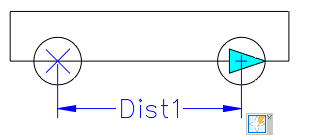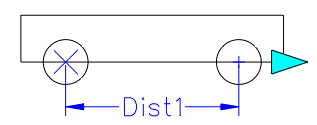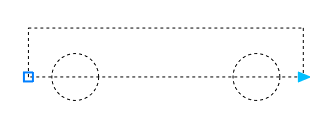Advanced Blocks parameters - BPARAMETER (Command)
Use the BPARAMETER command to add Parameters to Advanced Blocks entities that you want to modify.
A Parameter
defines extra properties and grip points for the Advanced Block that you
can customize outside the Block Editor. After adding the Parameter, you
must apply an activity to it.
Examples:
- Add a point Parameter to a point you want to move.
Add a linear Parameter to a line that you want to stretch.
To add a Parameter:
- In the Block Editor, enter BPARAMETER at the command prompt.
- Specify an option:
- Point. Defines X and Y attributes for the Block reference. The grip point position in the Block reference corresponds to the location of the point Parameter in the Advanced Block definition.
- Linear. Defines the distance between two points in the Advanced Block definition. The specified points in the Advanced Block definition determine the grip points position in the Block reference.
- Polar. Defines a distance and an angle for two points in the Advanced Block definition.
- XY. Defines the X and Y distance from the base point of the Advanced Block definition.
- Rotation. Defines an angle for the Advanced Block reference.
- Alignment. Defines an alignment axis and a grip point in the Advanced Block definition. This enables you to align the Block reference using the grip point.
- Flip. Specifies the position of a flipping axis and a grip point in the Advanced Block definition. This allows you to flip the Block reference using the grip point.
- Visibility. Adds a visibility Parameter to the Advanced Block definition. Within the Block reference, this grip point enables selection of visibility states.
- Lookup. Adds a Lookup Parameter to the Advanced Block definition.
- Basepoint. Defines a base point Parameter for the Advanced Block definition.
- The options correspond to the choices offered by individual Parameter commands in the Block Editor.
- Optionally, specify the Parameter properties. The properties set corresponds to the Parameter you add. After adding the Parameter, you can modify its properties at any time in the Properties palette.
- Follow the command prompts. The subsequent sequences of the BPARAMETER command are the same as those of the individual command variants. Click a link from the list of options above to view the command sequences.
Advanced Block Parameter Properties
The Properties palette organizes the following properties of the Advanced Block Parameters:
Note: The set of properties shown in the Properties palette are aligned with the Parameter specified in the graphics area.
Name
Specifies a custom name of the Parameter, which does not appear in the Properties palette.
Label
Indicates the label that identifies the Parameter in the graphics area and in the Properties palette (if specified). By default, Parameters have a generic label that can be modified.
Chain
Indicates if you want to include the Parameter in the selection set of an activity associated with a different Parameter.
Description
Specifies an additional description of the label. This description appears at the bottom when you select the Parameter label in the Properties palette.
Base
Indicates if you want to add a base point to the Parameter.
Palette
Specifies if you want to display the Parameter in the Properties palette (Yes/No).
Value Set
Specifies a set of values that can be assigned to the Parameter in the Block reference.
- List. Specifies a list of values available for the Parameter within the Block reference.
- Increment. Indicates the minimum and maximum value and an increment.
About Advanced Block Parameters
Parameters define the entities of the Advanced Block that are affected by the associated activity. You can incorporate Parameters into an Advanced Block definition using the tools available in the Block Editor.
Note: an Advanced Block definition must contain at least one Parameter.
In Advanced Block definitions, Parameters specify points, distances, and angles that you wish to modify within the Block reference.
When setting up an Advanced Block Parameter, you have the option to specify:
Special grip points to be shown on the Block geometry. Use these grip points to manipulate the Block reference outside the Block Editor. By default, grip points are displayed at the main points of the Parameter.
Labels for identifying the properties defined by the Parameter. These labels appear under Custom in the Properties palette, allowing you to modify values or select options. Double-clicking a Parameter label switches it to editing mode.
You can only use certain combinations of Parameters and activities. These Parameters are accessible in the Block Editor, and you can associate activities with them in the following manner:
Parameter |
Description |
Available activities |
Point |
Defines the X and Y properties of the Block reference. |
Move, Stretch |
Linear |
Defines the distance between two points in the Advanced Block definition. |
Move, Stretch, Scale, Pattern |
Polar |
Defines the distance between two points and displays an angle value. |
Move, Stretch, Scale, Pattern, Polar |
XY |
Defines the X and Y distance from the base point of the Parameter. |
Move, Stretch, Scale, Pattern |
Rotation |
Defines an angle for the Advanced Block reference. |
Rotate |
Alignment |
Defines an alignment axis for the Advanced Block reference. |
- |
Flip |
Defines a Flip axis for the Advanced Block reference. |
Flip |
Visibility |
Defines visibility states. You can add only one visibility Parameter to an Advanced Block definition. |
- |
Lookup |
Defines a custom property that you can associate with a list of defined values for other Parameters. |
Lookup activity |
Basepoint |
Defines one base point for the Advanced Block reference relative to the Advanced Block geometry |
- |
Use Parameters to define the properties and grip points of the entity you wish to customize making them visible and accessible outside the Block Editor.
Example:
Place a linear Parameter on a wall to specify that you want to change the wall length during the insertion. To change the length of a linear entity, assign a Stretch activity to the Linear Parameter.
Parameters Representation
In the Block Editor, Parameters appear quite similar to Dimensions. The software automatically includes grip points that are linked to the main points of the Parameters.
Note: Grip points are displayed in the Block reference only for Parameters that have associated activities.
In the Block Editor, Parameters without
associated activities display this icon. 
Grip points accessible in the Block Editor:
Grip Type |
Icon |
Modifications |
Standard |
|
Moves, stretches, scales, or patterns entities independently in a Block reference. |
Linear |
|
Lengthens, stretches, scales, or patterns entities in a Block reference in the direction specified by the Parameter. |
Rotation |
|
Rotates entities in a Block reference around an axis. |
Alignment |
|
Aligns entities of a Block reference with other entities in the drawing, either tangentially or perpendicularly. |
Flip |
|
Flips entities in a Block reference about an axis. |
Lookup/ Visibility |
|
Changes forms or dimensions based on predefined lists. Also, controls the visibility of subsets of entities based on lookup lists. |
Adding Grip Points to Advanced Blocks Definitions
You can create additional grip points for any Advanced Block, which allow you to modify the geometry of Block references outside the Block Editor.
To specify additional grip points in an Advanced Block definition, add Lookup Parameters to the entities you wish to modify and indicate the number of grip points you want to utilize. The position of the grip points in the Advanced Block definition corresponds to their position in the Block reference.
You can indicate the number of grip points at any time in the Properties palette, under the Nr. of grips property.
Example:


A linear Parameter for a wall is set by default to have two grip points available. You can use both grip points or only one as needed.
When you add a Parameter to an Advanced Block definition, grip points appear at the main points of the Parameter (these are points you can use to manipulate the Block reference). Altering the grip point position doesn't impact the link with the main point. However, moving the grip point in the Block reference does affect the main point it's linked to.
Ensure the grip points are correctly positioned within the Advanced Block definition to prevent potential confusion and undesired results.
Example:
In the following example, a linear Parameter defines a grip point. The move activity associates the grip point with the right circle and the end point of the Parameter, which is the center of the circle.
Changing the grip point location in the Advanced Block definition does not affect the link with the main point (the center of the circle). In the Block reference, moving the grip point moves the right circle.
Grip point at the main point position
Moving the grip point in the Block reference moves the circle.


Grip point in a different position
Moving the grip point in the Block reference moves the circle.



Specifying Insertion Cycling for Grip Points
Any grip point specified in the Advanced Block definition can be utilized as an insertion point in the Block reference.
Pressing the Ctrl key when inserting an Advanced Block with multiple insertion points allows you to insert the Block from multiple positions. Still, the basepoint position does not change.
Specifying Value Sets for Advanced Blocks
Use value sets to limit a Parameter to specific values when inserting a Block reference in a drawing.
You have the option to define a value set for these Parameters:
Linear
Polar
Rotation
There are two methods to define value sets:
In the form of a list of values
As increments within a specified range.
Example:
In this example, where an Advanced Block is defined to draw rectangular tables of various lengths, you can restrict the values by doing one of the following:
List the allowable values for the length: 100, 120, 140 and 160 mm.
Establish the range of values (from 100 .. 160) and the increment, for example 20. You can stretch the table to only 100, 120, 140, and 160mm.
To specify a value set for a Parameter:
Open the Advanced Block in the Block Editor.
In the graphics area, specify the Parameter.
In the Properties palette, under Value Set, select an option:
Increment. Specify the increment and the range of values:
Increment. The difference between the values in the sequence.
Initial value. First value in the sequence.
End value. The last value in the sequence.
List. Click "3 dots" button to specify the list of values in the Value Set List dialog box.
Add to add a specified value.
Delete to delete a value, selected from the list.

 en
en italiano
italiano čeština
čeština Deutsch
Deutsch français
français hrvatski
hrvatski magyar
magyar polski
polski српски
српски русский
русский 中文
中文 中文
中文 한국어
한국어 español
español




